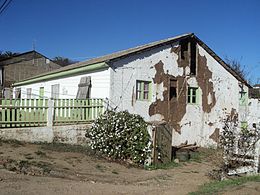2010 Pichilemu earthquake

Above: House damaged by the Pichilemu earthquake, in the epicentre town, as seen on 16 April 2011. Below: Pichilemu earthquake produced by the United States Geological Survey
|
|
 |
|
| Date | 11 March 2010 |
|---|---|
| Origin time | 11:39:41 UTC-3 |
| Magnitude | 6.9 Mw 6.3 ML |
| Depth | 33.1 kilometres (20.6 mi) |
| Epicenter |
Pichilemu, Chile 34°18′04″S 72°07′48″W / 34.301°S 72.13°WCoordinates: 34°18′04″S 72°07′48″W / 34.301°S 72.13°W |
| Areas affected |
Chile Argentina |
| Max. intensity | MM X |
| Peak acceleration | 0.086g (Curicó, Maule) |
| Tsunami | Yes |
| Casualties | 1 killed |
The 2010 Pichilemu earthquake (Spanish: Terremoto de Pichilemu de 2010), also known as the Libertador O'Higgins earthquake, was a 6.9 MW intraplate earthquake that struck Chile's O'Higgins Region on 11 March 2010. The earthquake was centred 15 kilometres (9.3 mi) northwest of the city of Pichilemu, according to the University of Chile Seismological Service.
The earthquake was caused by increased regional stress arising from an earthquake on 27 February, centered offshore Maule Region, which was felt throughout central Chile. The 11 March earthquake was at first thought to be an aftershock from the 27 February event, but University of Chile Seismologist Jaime Campos identified it as an "independent earthquake". The Hawaii-based Pacific Tsunami Warning Center pointed out the possibility of local tsunamis within 100 kilometres (62 mi) of the epicentre, although small, but violent waves were seen in the Pichilemu and Bucalemu area. One person was reported dead. At least eleven aftershocks immediately followed, causing panic throughout coastal towns between the Coquimbo and Los Lagos regions.
The earthquake was specially destructive in the epicentre town, Pichilemu, capital of Cardenal Caro Province. The city hosts five National Monuments of Chile, of which two, the Agustín Ross Park and the Agustín Ross Cultural Centre, were seriously damaged by the earthquake. It also damaged the villages of La Aguada and Cardonal de Panilonco. Rancagua, the capital of O'Higgins Region, was also damaged, leading President Sebastián Piñera to declare a catastrophe state in O'Higgins Region.
...
Wikipedia
